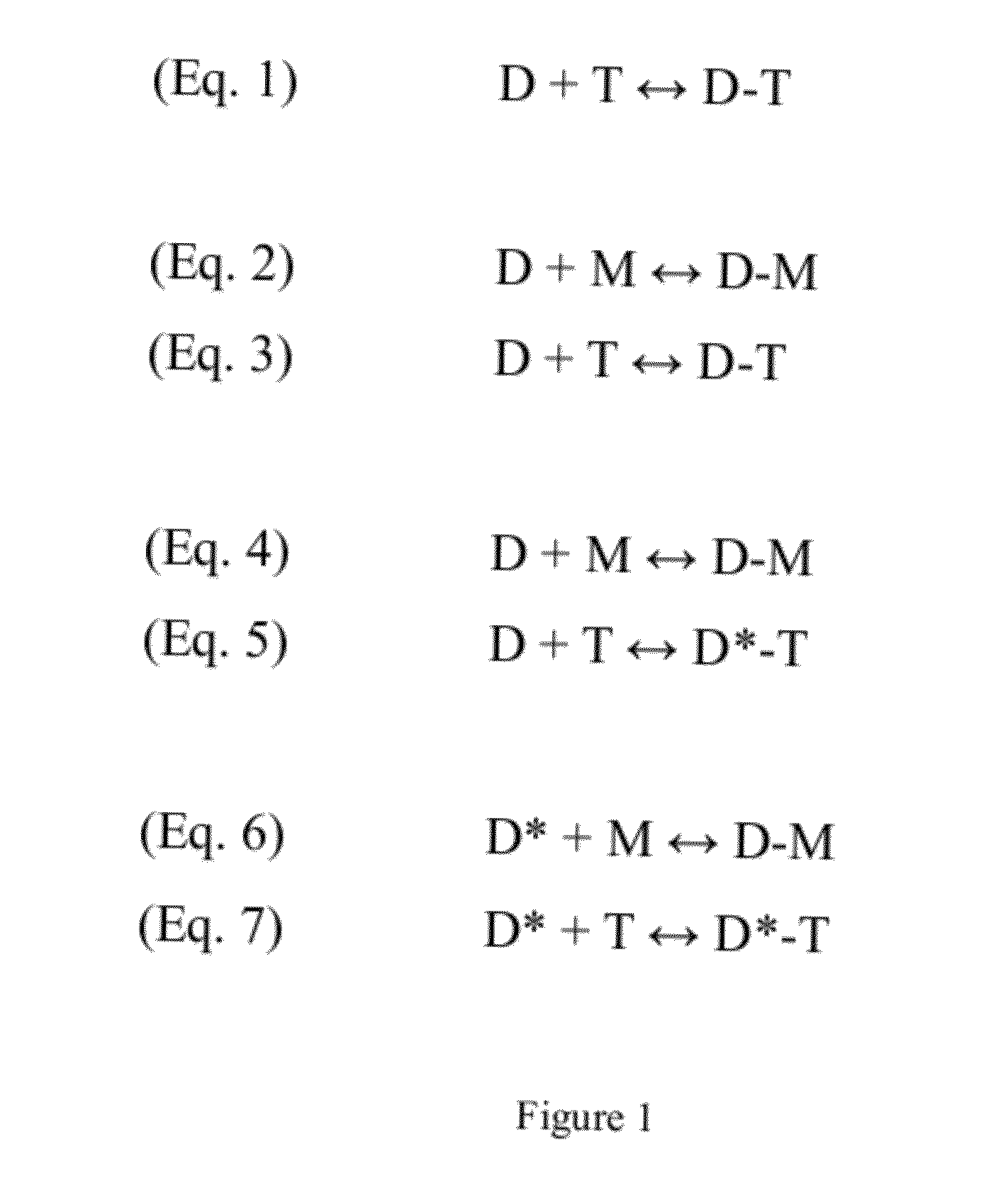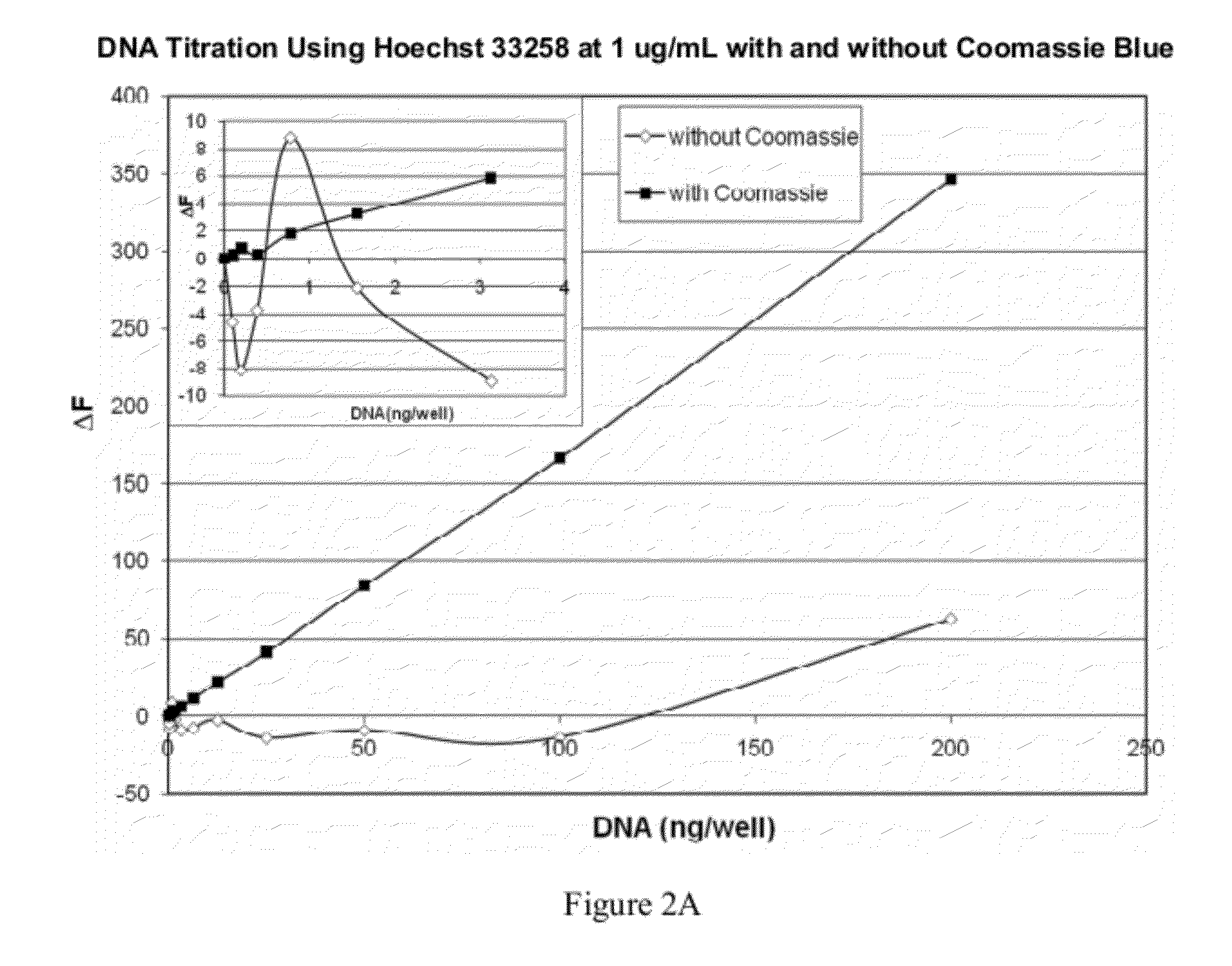Detection using a dye and a dye modifier
a technology of dye and modifier, applied in the field of detection using dye and dye modifier, can solve the problems of limited sensitivity and high background fluorescence of dye, limit the detection sensitivity of dye,
- Summary
- Abstract
- Description
- Claims
- Application Information
AI Technical Summary
Benefits of technology
Problems solved by technology
Method used
Image
Examples
example 1
Comparison of DNA Quantitation by a Light-Emitting Dye with and without a Dye Modifier
[0104]The sensitivity and linearity of a light-emitting dye, such as Hoescht 33258 dye at 1 μg / mL for quantitation of DNA can be improved using Coomassie Blue R250 as a dye modifier at a molar ratio of 1:5, as evidenced by the graphs shown in FIG. 2A and FIG. 2B. FIG. 2A and FIG. 2B compare the linearity and dynamic range of DNA quantitation using Hoechst 33258 with and without Coomassie Blue. FIG. 2A compares a low range of DNA quantitation (from 0 to 200 ng) using 1 μg / mL Hoechst 33258 with and without Coomassie Blue. Inset graph of FIG. 2A depicts the lower range of the DNA titration. FIG. 2B compares a wider dynamic range of DNA quantitation (from 0 to 4000 ng) using 1 μg / mL Hoechst 33258 with and without Coomassie Blue.
[0105]The data shown in FIG. 2A was obtained under the following conditions: Hoechst 33528 at 1 ug / mL with and without a 1:5 molar ratio of Coomassie Blue R250 was prepared in 1...
example 2
Comparison of DNA Quantitation by Hoechst 33258 at 0.1 μg / mL with and Without Coomassie Blue as a Modulating Reagent
[0107]The sensitivity and dynamic range of Hoescht 33258 dye at 0.1 μg / mL for quantitation of DNA can be improved using Coomassie Blue 8250 as a dye modifier at a molar ratio of 1:5, as evidenced by the graphs shown in FIG. 3. FIG. 3 compares the linearity and sensitivity of DNA quantitation using 0.1 μg / mL of Hoechst 33258 with and without Coomassie Blue. These data show that reducing the Hoechst 33258 dye concentration down to 0.1 μg / mL increases the lower detection limit, but also reduces the dynamic range of detection. Moreover, the addition of Coomassie Blue improves the linearity of the assay at the lower DNA titration range, and increases the dynamic range of detection.
[0108]The data shown in FIG. 3 was obtained under the following conditions: Hoechst 33528 at 0.1 ug / mL with and without a 1:5 molar ratio of Coomassie Blue R250 was prepared in 1×TE buffer (10 mM ...
example 3
Comparison of DNA Quantitation by EvaGreen With and Without Coomassie Blue as a Modulating Reagent
[0109]The sensitivity and linearity of EvaGreen dye at 0.5× can be improved using Coomassie Blue R250 as a dye modifier, as evidenced by the graphs shown in FIG. 4A and FIG. 4B. FIG. 4A and FIG. 4B compare the sensitivity and linearity of DNA quantitation using EvaGreen with varying amounts of Coomassie Blue. Coomassie Blue was either omitted or added at 1:1, 1:2 or 1:5 (modulating agent / dye) molar ratio to a solution of EvaGreen. FIG. 4A depicts the lower range of DNA quantitation from 0 to 3 ng. FIG. 4B depicts a wider dynamic range of DNA quantitation from 0 to 100 ng. These data show that the addition of Coomassie Blue improves the lower detection limit and sensitivity of DNA quantitation by EvaGreen alone. Also importantly, these data illustrate that the use of a modulating reagent to increase sensitivity and linearity of DNA quantitation is applicable to various dyes.
[0110]The dat...
PUM
 Login to View More
Login to View More Abstract
Description
Claims
Application Information
 Login to View More
Login to View More - R&D
- Intellectual Property
- Life Sciences
- Materials
- Tech Scout
- Unparalleled Data Quality
- Higher Quality Content
- 60% Fewer Hallucinations
Browse by: Latest US Patents, China's latest patents, Technical Efficacy Thesaurus, Application Domain, Technology Topic, Popular Technical Reports.
© 2025 PatSnap. All rights reserved.Legal|Privacy policy|Modern Slavery Act Transparency Statement|Sitemap|About US| Contact US: help@patsnap.com



